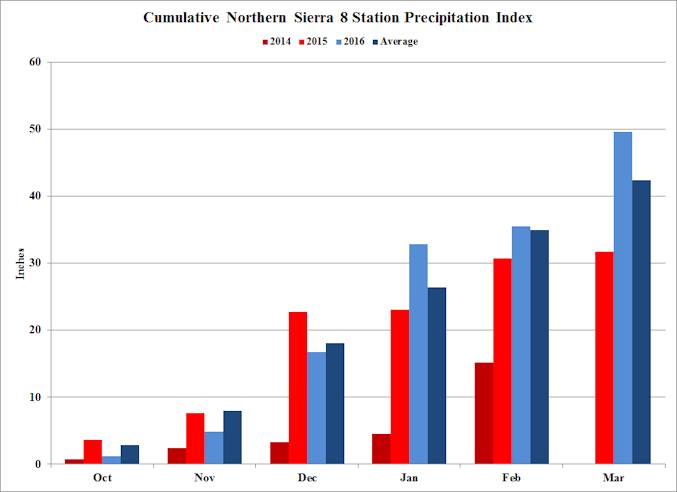March storms lead DWR to increase its announced SWP Allocation to 45%. Cumulative precipitation through March stands almost 8 inches above the historical average (see precipitation chart). This is the fourth announced allocation for the 2016 water year that started at 10% in December 2015 when precipitation was running behind the level of the prior year and below the historical average. January was a favorable month where cumulative precipitation exceeded the historical average. DWR increased its SWP Allocation in late January 2016 to 15% when JOW forecasted an even higher 22% SWP Allocation. With storms in late February, DWR increased its SWP Allocation to 30%.

DWR’s current announcement of 45% is significantly greater than Journal of Water’s updated prediction for the 2016 Final Allocation. Updating JOW’s forecast for the 2016 Final Table A Allocation for actual precipitation as measured by the Northern Sierra 8 Station Index through mid-March, the expected final allocation is 31% (see Probability Distribution Chart). There is about 83% chance that the final allocation will be below 45% and only a 17% chance that the final allocation will be above 45%.

There is the fickleness of Mother Nature. What will precipitation bring through April? January storms started a continuing favorable factor towards increased SWP allocations. Based on the historical relation between the cumulative precipitation for October-April precipitation and the cumulative precipitation for October-March as measured by the Northern Sierra 8 Station Index, the expected precipitation for October-April now stands at 55 inches, or 118 percent of the historical average. The predicted 31% allocation in the face of above normal precipitation reflects the low storage in Oroville at the beginning of the water year and the declining trend in SWP Allocations reflecting environmental restrictions. (For further discussion of the factors driving SWP allocations, see California DWR Announces Initial SWP Allocation, JOW, December 2015).
The March storms meant that DWR did not need to install a drought barrier to control salinity in the Sacramento-San Joaquin Delta. A barrier was installed for six months in 2015 to control salinity for Delta residents and Californians dependent on Delta water.
Despite the increased SWP allocation, DWR notes that the drought has not ended. “Although California is on track to end the winter season with near-average conditions, one such season does not compensate for four prior years of drought. Accurately predicting whether water year 2017 will be wet, dry or average is beyond the skill of climate forecasters, and we must be prepared for the possibility of a dry 2017. Even with reservoir levels rising, conservation is the surest and easiest way to stretch supplies.”
Written by Rodney T. Smith, Ph.D.
You must be logged in to post a comment.